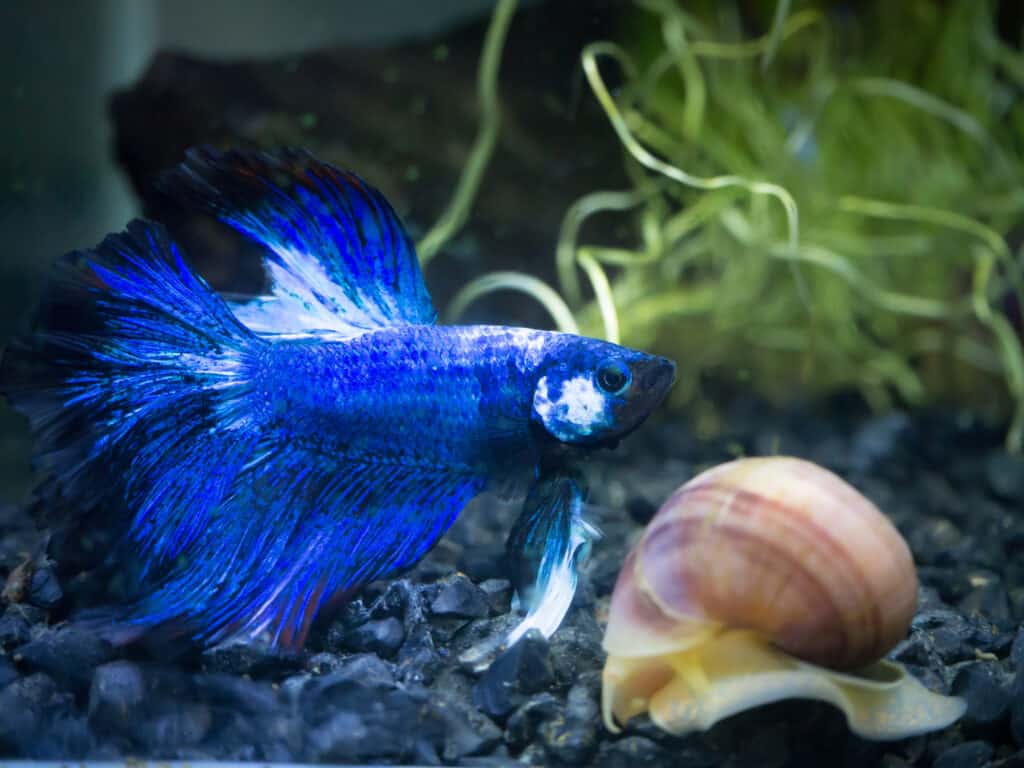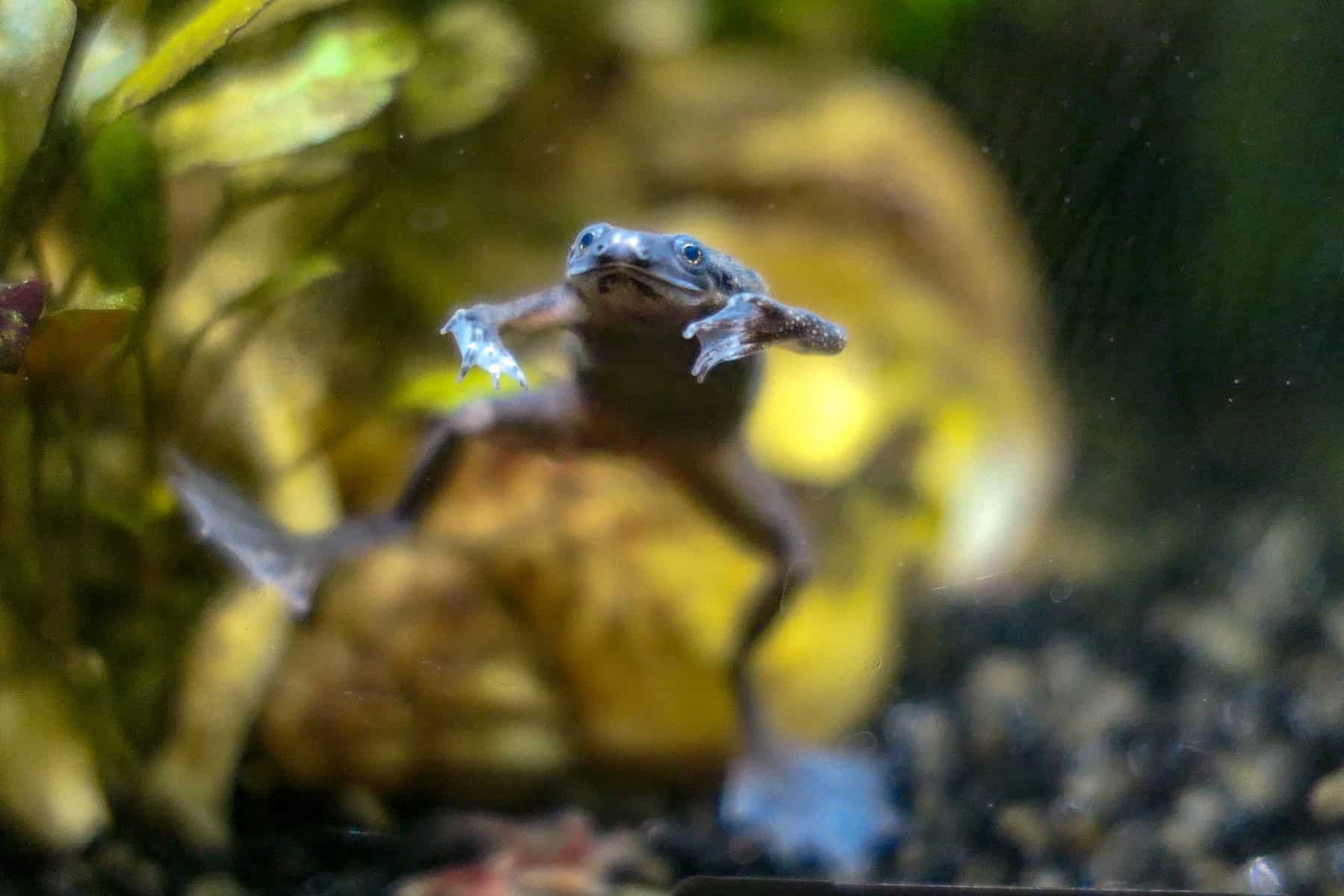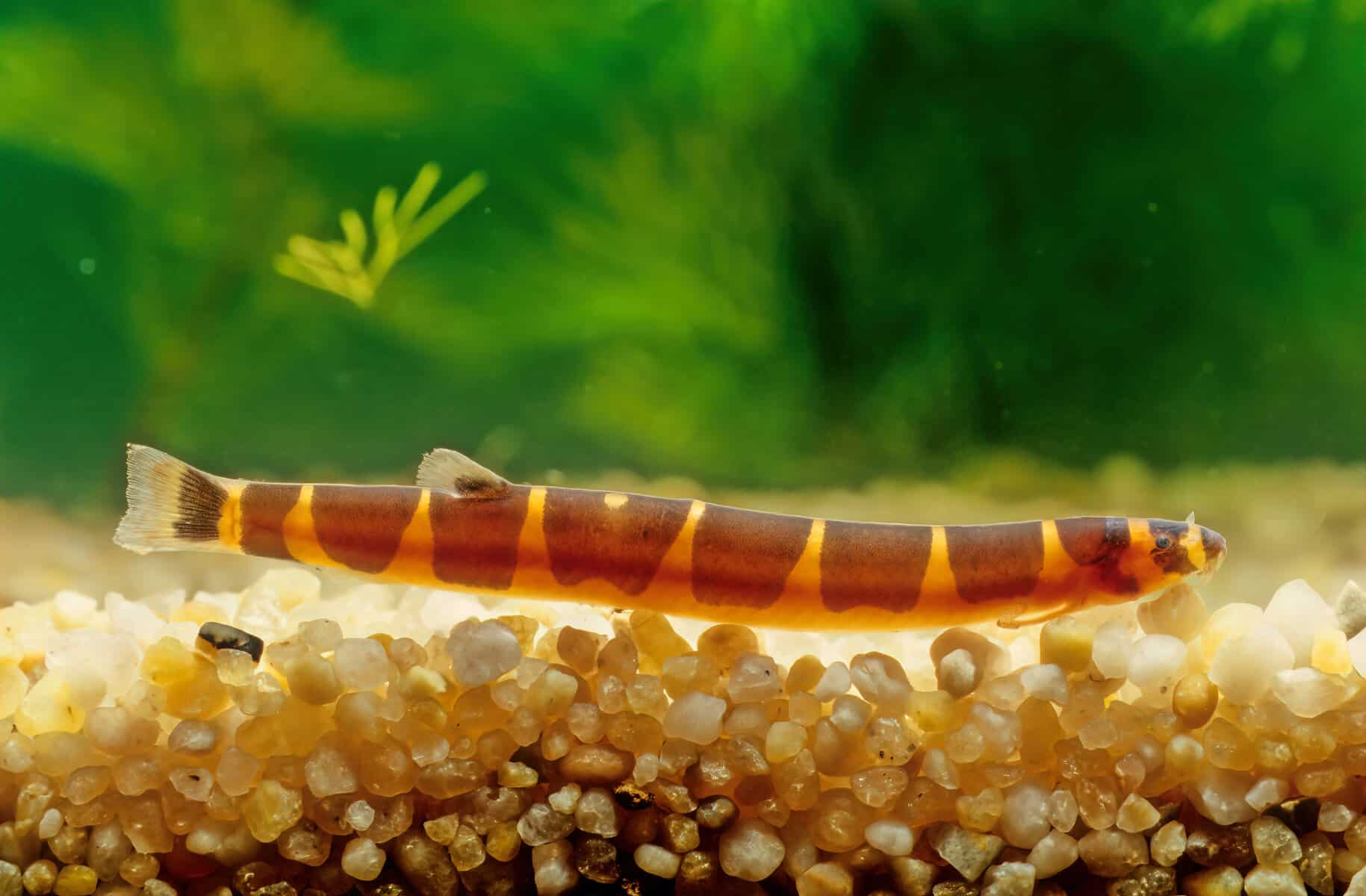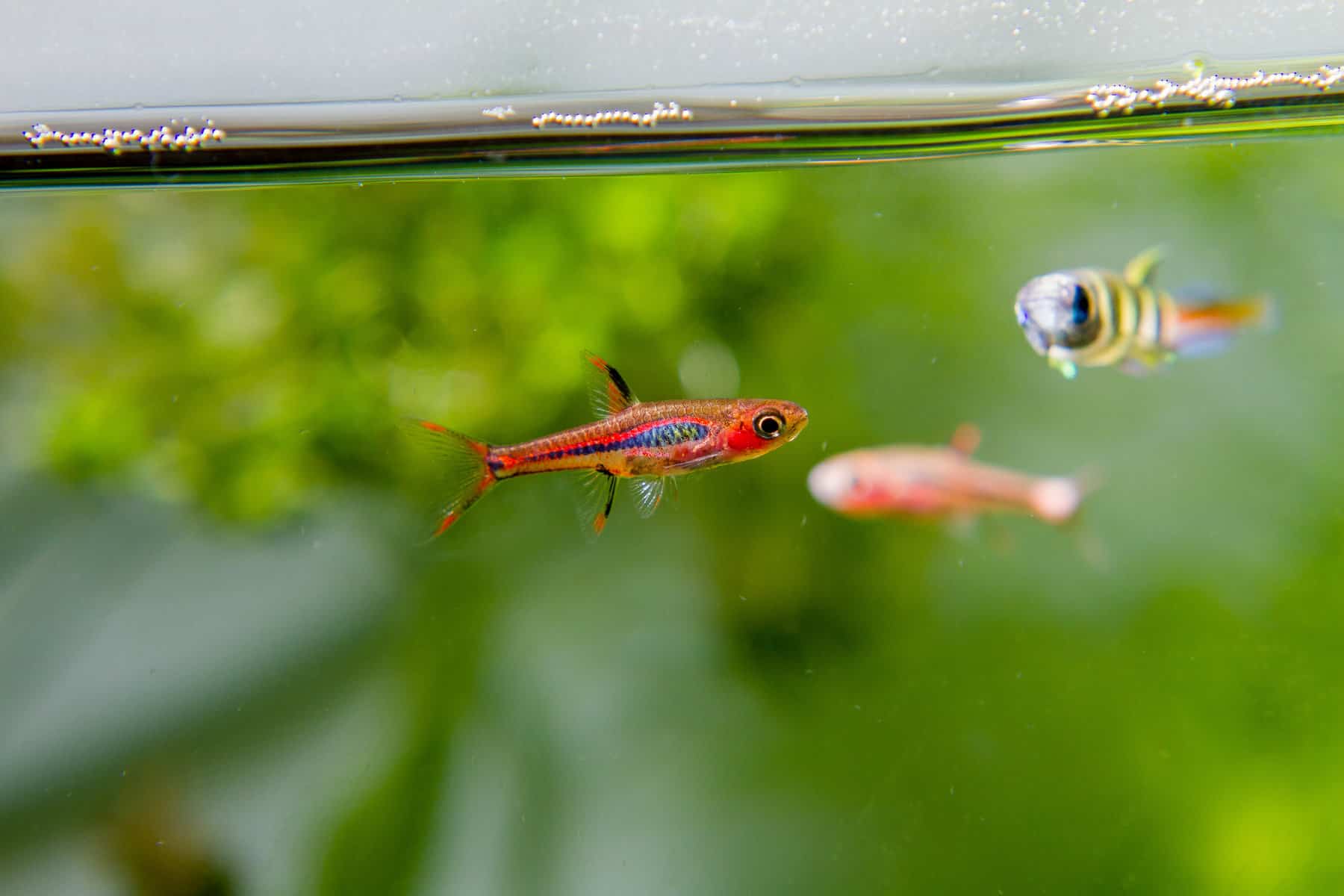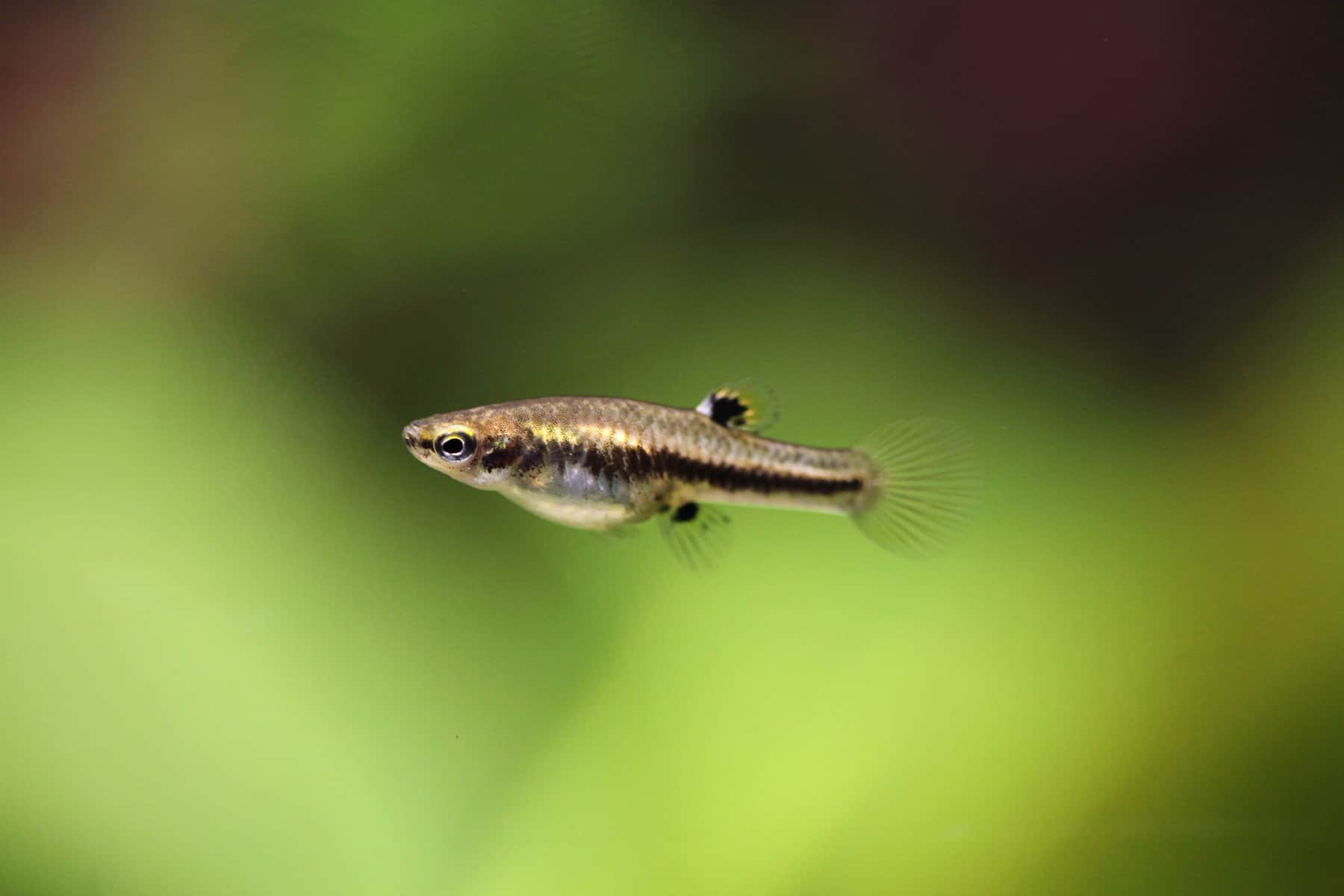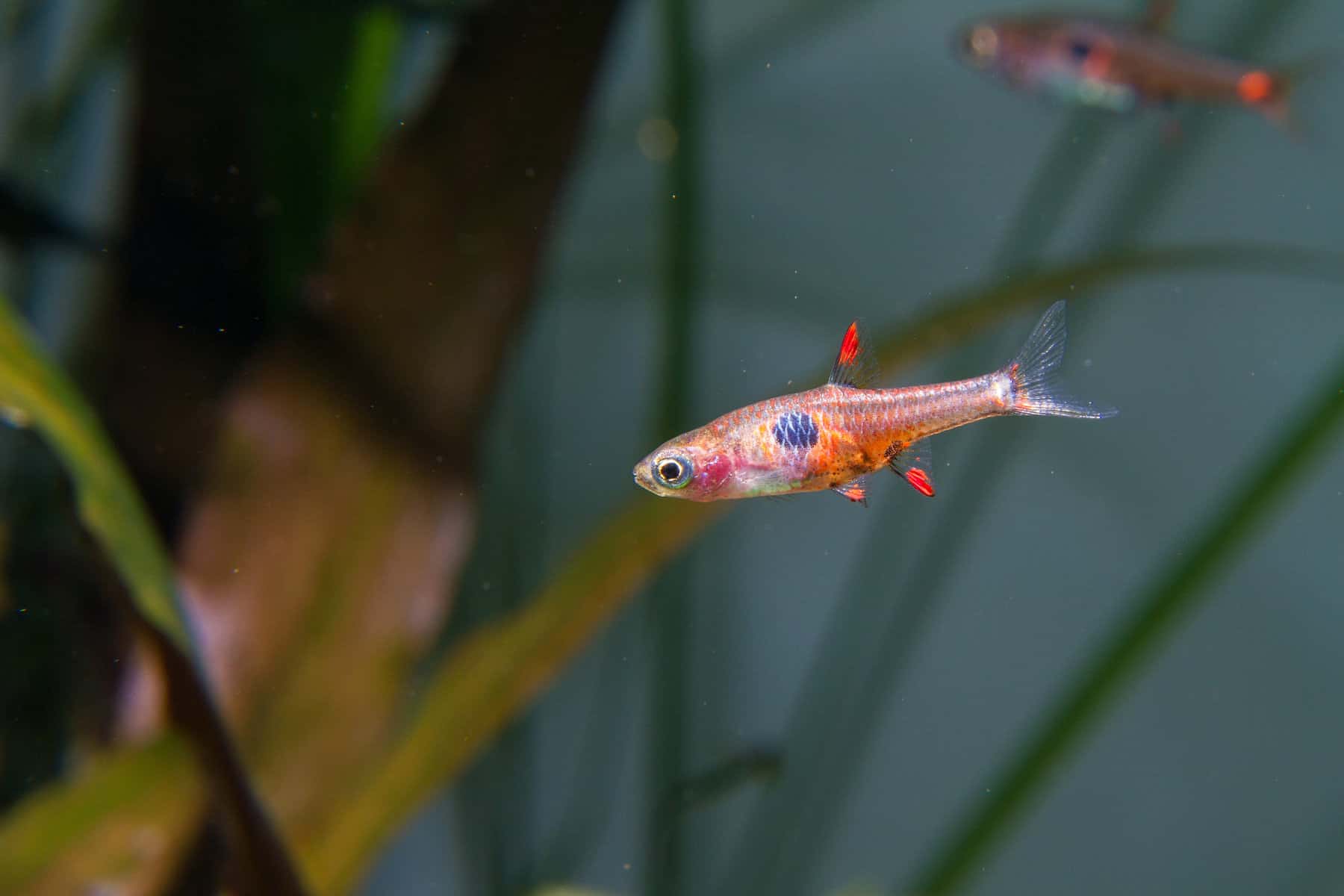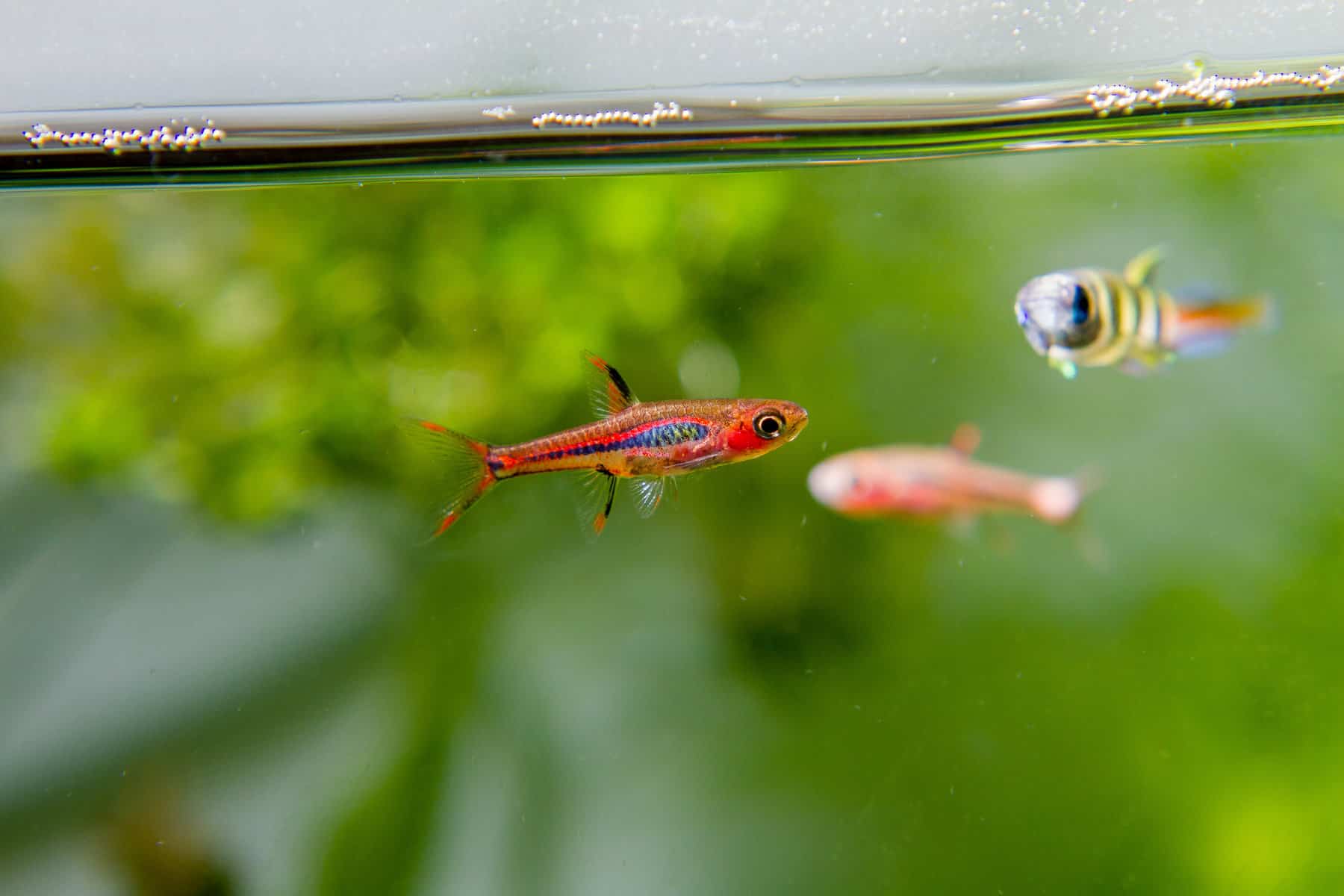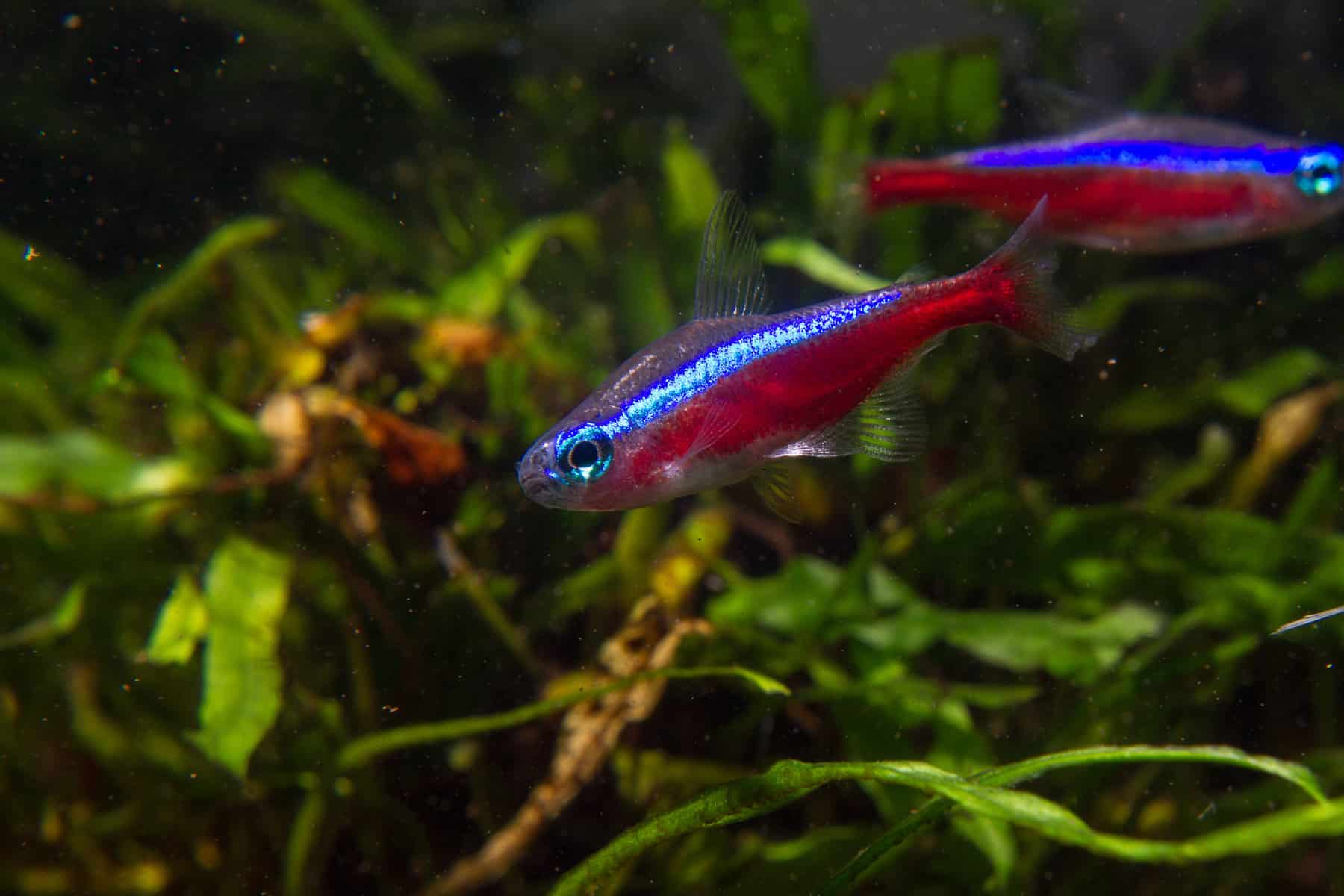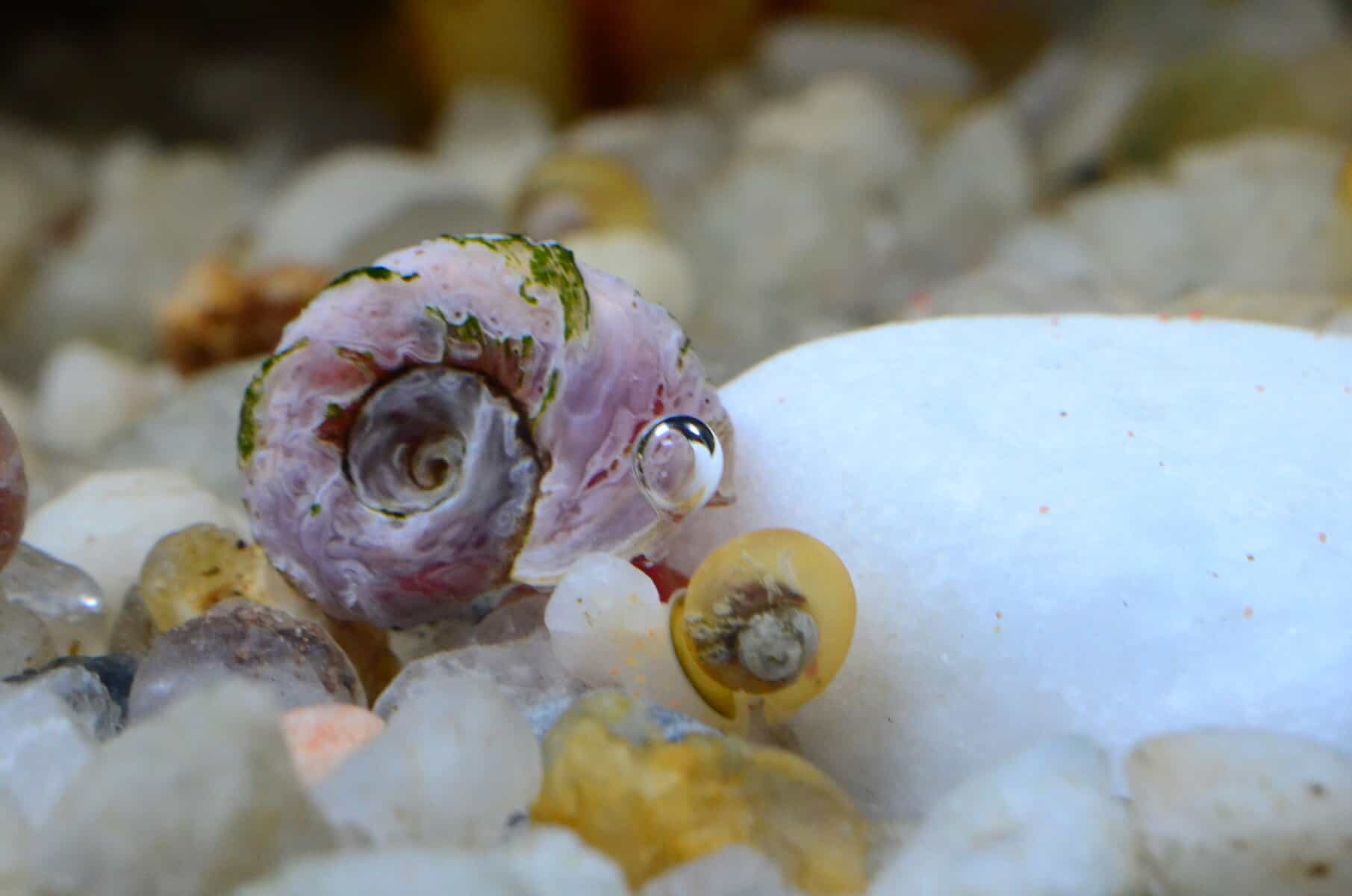You’re probably concerned about your lonely betta fish. I had a betta for years, and I felt so bad leaving him in his little tank all by himself.
I began researching what other fish I could put in with him and eventually came up with a nice little list of potential mates.
In this article, I will share with you these different 5-gallon tank mates for betta fish so that your little guy (or girl) won’t be so lonely anymore!
African Dwarf Frog
- Care level: Intermediate
- Temperament: Peaceful
- Maximum size: 3 Inches
- Average lifespan: 5 Years
- Diet type: Omnivore
- Water temperature: 72-78°F
- pH level: 4-15
- Water hardness: 6.5-7.8
- Breeding: Egg layers
Although African dwarf frogs are very gentle, they may mistakenly bite your Betta’s fins. To avoid this, you can keep them with female bettas since they have much smaller fins than their male counterparts.
These frogs are entirely aquatic animals that spend the bulk of their time in the aquarium and seldom on the surface to breathe. Thus, please don’t leave them out of water for more than 10 to 15 minutes because they will become dehydrated.
To ensure their health, perform regular water changes and provide them with a diet of mosquito larvae, brine shrimp, krill, earthworms, and fish fry.
Kuhli Loach
- Scientific name: Pangio kuhlii
- Care level: Intermediate
- Maximum size: 4 inches
- Average lifespan: 10 years
- Diet type: Omnivore
- Water temperature: 75° –86°F
- pH level: 6.0–6.5
- Water hardness: up to 10° DH
- Breeding: Egg Layer
The Kuhli loach is a shy, eel-shaped creature that likes to hide behind plants and roots in its aquatic home.
Also, these scavengers spend most of their time on the aquarium floor searching for uneaten food. So, they are an ideal cleaning crew for your 5-gallon betta tank!
The Kuhli loach is nocturnal, taking breaks during the daytime, whereas bettas are diurnal animals that rest at night. Consequently, these two fish can coexist in the same aquarium without any difficulties.
Malaysian Trumpet Snail
- Scientific name: Melanoides tuberculata
- Care level: Easy
- Maximum size: 1 inch
- Average lifespan: 1 year
- Diet type: Omnivore
- Water temperature: 70 – 78°F
- pH level: 7.0 – 7.5
- Breeding: Egg layers
These snails are more active at night when Betta fish are resting. So, your Betta might not even know they are there!
Additionally, Trumpet snails are opportunistic feeders and will consume most of the uneaten food and algae in your tank, making it cleaner and healthier for all the inhabitants.
Aside from that, you should also provide them with algae wafers and bottom feeder tablets to ensure their diet is balanced and nutritious.
More to add, Malaysian trumpet snails reproduce rapidly and in high numbers. Therefore, you must limit their food intake since the more food these snails have access to, the greater Their population will be.
Pygmy Corydoras
- Family: Callichthyidae
- Scientific Name: Corydoras pygmaeus
- Common Name: Pygmy Corydoras
- Origin: Brazil, Peru, and Ecuador
- Color: Silver with black horizontal lines
- Size: 1.2 inches
- Lifespan: Up to 3 years
- Water temperature: 22 – 28 degree Celsius
- pH level: 6.0 – 7.5
- Care Level: Beginner
- Temperament: Peaceful fish
The Pygmy Corydoras is a type of armored catfish that has a peaceful temperament and makes an excellent tank mate for betta fish.
This little guy originates from South America and is one of the smallest species of Corydoras, only reaching a maximum length of 1.2 inches.
Brigittae Rasbora
- Common names: Rasbora brigittae, R. urophthalma brigittae
- Origin: Southern Borneo, Indonesia
- Sexual dimorphism: In adulthood, males usually have brighter colors, while females tend to be larger and rounder in the belly.
- Maximum size: 1.4 inches
- pH level: 4.5-7.0
- Water hardness: up to 8 degrees
- Water temperature: 25-28 deg C (77-82 deg F)
The Brigittae Rasbora fish originate from blackwater streams in Indonesia that move slowly. This makes them perfect pals for bettas who hate strong currents.
To keep them comfortable in your 5-gallon fish tank, provide them with plenty of hiding spots and a soft, sandy substrate.
Also, you should keep them in schools of at least six fish to reduce stress levels and enable them to feel more secure in their new environment.
Least Killifish
- Family: Poeciliidae
- Scientific name: Heterandria formosa
- Origin: Water bodies of North America
- Size: 0.8 – 1.4 inches
- Lifespan: Up to 5 years
- Temperature: 69-79°F (21-26°C)
- Water Hardness: 5 – 20 dKH
- Water pH Level: 6.5 – 8.0
- Care Level: Easy
- Temperament: Peaceful
- Diet: Omnivores
- Breeding: Livebearer
The least killifish are relatively small in size. Still, as livebearers, they will quickly begin to breed in your 5-gallon tank if you don’t take precautions.
To avoid an overpopulation problem, you can keep all males or all females together.
Strawberry Rasbora
- Scientific name: Boraras Naevus
- Common name: Strawberry Rasbora
- Origin: Malaysia, Thailand, Singapore, Sumatra, and surrounding areas
- Temperature: 68 – 82.4° F (20° – 28° C)
- pH level: 4.0 – 7.0
- Size About 0.7 inches
- Diet Omnivorous / prefers Carnivorous
Strawberry rasbora prefers slow-moving water with a slightly acidic pH and a heavily planted tank, making them the perfect friends for a betta.
Also, they are peaceful by nature, so you won’t have to worry about them bullying your Betta or nipping its fins.
Celestial Pearl Danio
- Scientific name: Danio margaritatus
- Common names: Celestial pearl danio, galaxy rasbora, fireworks rasbora
- Origin: Myanmar and northern Thailand
- Size:0.75–1 inch
- Lifespan: 3–5 years
- Color: Dark blue with white/yellow spots in a galaxy pattern
- Diet: Omnivore
- Temperament: Peaceful
- Minimum tank size: 10 gallons
- Temperature: 71–78°F (21.6–25.5°C)
- pH: 6.5–7.5
- Hardness: 1–5 dGH
- Care level: Moderate
- Breeding: Egglayer
The celestial pearl danio is very beautiful and often shy. Still, if you have a large enough group, they can become bold enough to dance!
Although they do well in 5-gallon aquariums and have a comparable disposition to bettas, they like slightly cooler water than bettas, so keep that in mind while preparing your tank.
Ember Tetras
- Scientific Name: Hyphessobrycon amandae
- Origin: Brazil
- Size: 0.6 – 0.8 inches
- Food & Diet: Omnivorous
- Lifespan: 2 and 4 years
- Temperature: 77-82°F (22 -28°C)
- Water pH: 6.0-7.0
- Breeding: Egg Scatterers
Ember tetras are a peaceful, small, and bright red species of freshwater fish. Usually, they do best when living in schools with at least six other ember tetras.
To preserve their glowing, you should offer them high-quality flake diets. Also, they’re a fairly hardy fish, so they’re perfect for beginner aquarists.
Phoenix Rasbora
- Family: Cyprinidae
- Scientific name: Boraras merah
- Origin: Southern Region of Borneo
- Lifespan: Maximum 7 years
- Colors: Silver, red, and orange body with black markings.
- Temperament: Peaceful
- Care level: Moderately easy
- Size: 0.5-0.8 inch
- Compatibility: Mostly social
- Breeding: Egg-scatterer
The Phoenix rasbora is a tiny, orange-red rasbora that is calm and simple to care for. They enjoy slow-moving, acidic water like the strawberry and brigittae rasboras leaving you with many different options for tank mates!
Neon Tetras
- Scientific name: Paracheirodon innesi
- Origin: Brazil, Colombia, Peru
- Size: 1–1.5 inches
- Life expectancy: 6–8 years
- Color: Blue, silver, or translucent with red markings
- Diet: Omnivore
- Temperament: Peaceful
- Minimum tank size: 10 gallons
- Temperature: 70–81°F (21–27°C)
- pH: 6.0–7.0
- Hardness: 2–10 dGH
- Care level: Easy
- Breeding: Egg scatterer
Neon tetras are hardy, but they need specific water conditions in order to thrive. These fish have a brilliant neon-blue line down the top portion of their bodies with a vibrant crimson stripe extending from their white-silver belly to their tail.
Don’t be concerned when your neon tetra’s color fades during the night. These fish are nocturnal, so their colors will be more subdued at night.
Dwarf Rasbora
- Scientific name: Boraras maculatus
- Common names: Dwarf rasbora, pygmy rasbora, spotted rasbora
- Origin: Malay Peninsula, Thailand, Sumatra, Singapore, Indonesia
- Size: Up to 1 inch
- Life expectancy: 3–5 years
- Color: Red with black splotches
- Diet: Omnivore
- Temperament: Peaceful, timid
- Temperature: 75°–79°F (24°–26°C)
- pH: 4.5 – 6.8
- Hardness: 1– 5 dGH
- Care level: Intermediate
- Breeding: Egg scatterer
Although they don’t have as bright colors due to their more translucent nature, these rasboras can still look great in your aquarium! Dwarf rasboras stay relatively small, only growing to be about an inch in length.
Ramshorn Snails
- Scientific name: Planorbidaefamily
- Origin: North America
- Size: 1–2 inches wide
- Life expectancy: 1–2 years
- Color: Red, black
- Diet: Omnivore
- Temperament: Peaceful
- Minimum Tank Size: 2 gallons
- Temperature: 64–86°F (23–28°C)
- pH: 7.0–8.0
- Hardness: 8.0–18.0 dGH
- Care level: Easy
Ramshorn snails are one of the best snail friends for your Betta for two reasons:
- I don’t recommend housing large snails, such as nerites or mystery snails, since Bettas will continually bully them and try to devour their eye stalks. This isn’t a problem in a bigger tank with lots of greenery, but it would end badly for the snail in a 5-gallon tank.
- The majority of the smaller snails you could add are considered nuisances. Although Ramshorn snails are still nuisances, they come in different hues such as bright red and pink, blue ones, striped ones, leopard-spotted ones, and even tiger-striped varieties.
Bladder/Pond Snails
- Care Level: Very easy
- Temperament: Peaceful
- Color: Greyish with yellow spots
- Lifespan: Up to 2 years
- Size: About 1/2 inch
- Diet: Omnivore/Algae
- Family: Physidae
- Minimum Tank Size: Any size
- pH: 7.0-8.0
- Compatibility: At-risk from aggressive fish
Although they are not the most attractive creatures, snails are quite helpful and will do their part in keeping your aquarium clean.
They’re scavengers that will consume algae, uneaten food, dead plant matter, and really anything else they can get their mouths on!
